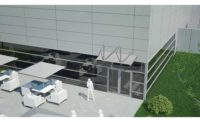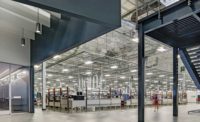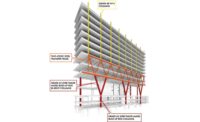As manufacturing facilities for everything from electric vehicle components to the crystalline photovoltaic wafers in solar panels are funded by government incentive as well as private investment, design firms are being called on to redesign production processes dependent on the materials and regulations that long-favored overseas manufacturing. Arcadis is one engineer-architect taking on the challenge with CubicPV’s 10-GW silicon solar wafer manufacturing facility, announced Aug. 15 for a U.S. site.
CubicPV is partially funded by Bill Gates’ Breakthrough Energy Ventures investment arm and has raised $103 million to date that the company says it plans to invest in its domestic solar wafer manufacturing facility. Although a site hasn’t yet been decided on, both Arcadis and CubicPV insist their plans to have the project completed by the end of 2024 are reasonable.
Since the U.S. currently lacks any domestic solar ingot, wafer or cell manufacturing capacity, being able to create the energy-absorbing parts of panels is a big need for both utility-scale and home solar. The existing domestic solar facilities—such as Tesla’s Buffalo, N.Y., GigaFactory 2—all assemble their final products with silicon wafers or crystals made outside the U.S. Many sustainable energy products, such as PV wafers, have never been mass-manufactured in the U.S., according to trade group the Solar Energy Industries Association.
“A lot of things that they do in China cannot be done here just because of regulations and safety code requirements,” says Ketan Maroo, Arcadis vice president for industrial manufacturing and a co-project leader on CubicPV. “That’s where the design acumen comes into play, and also the automation piece comes into play. We want to do it in such a way that we don’t increase the cost of actually manufacturing that product, but at the same time [we are able to] meet the core requirements and the safety requirements we have here.”
Arcadis is providing multidisciplinary engineering, architecture, advanced industrial process design and project management services for the solar manufacturing facility. Maroo said Arcadis will also engage with stakeholders of the project, including the contractor when one is named. Maroo and Matt DeMarco, fellow Arcadis vice president, said that designing the process engineering is a part of the firm’s scope of work and they’ve already begun work on integrating the machinery that will produce the wafers, including the tooling that will produce silicon ingots.
“It’s not just the building envelope, we’re building the entire process, from inside out,” DeMarco said. “A lot of advanced manufacturing facilities have to design inside for all of the lines of production and then make the building fit the needs of that production and future growth.”
DeMarco added that CubicPV’s sales offices will also be located in the facility. Arcadis said in a statement that project scoping and front-end engineering design work have already been completed.
Maroo said recent acquisitions helped Arcadis add to its manufacturing expertise and win the RFQ process that began a year ago.
“We thought we had a good shot at it because we can offer everything in-house,” he said. “We could support them in China because we have offices there. We can support them in the U.S. with our offices here and, of course, our recent DPS and IBI Group acquisitions enhanced our advanced manufacturing capability.”
The challenge of onshoring the manufacturing of sustainable technologies, such as solar panels, largely contingent on foreign regulations and supply chains, will have to be met by manufacturers, designers and, eventually, contractors.
“Their familiarity in executing large global projects, industry leadership, solid record in design and consultancy and focus on sustainability were deciding factors during the selection process,” David Gustafson, president of Cubic PV unit Cubic Wafer, said in a statement that highlighted Arcadis’ related experience and capabilities.






Post a comment to this article
Report Abusive Comment